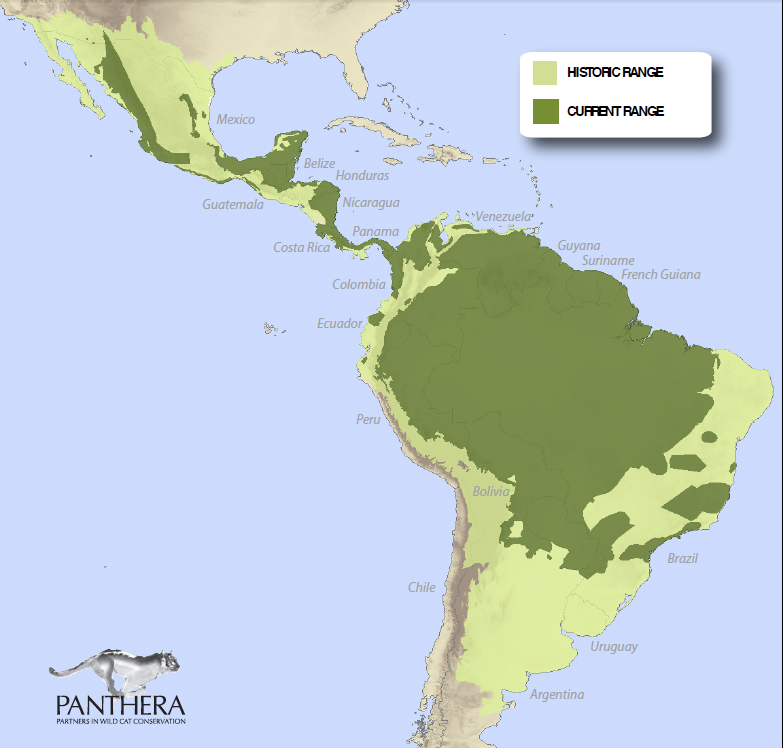Conrad d'Leeuwen
Bio 227
M-W 12-2pm
November 16, 2015
The Ocelot is a small carnivorous species of cat. They are about the same size as a standard house cat. Weight: 15-40 lbs. Length: 2.5 -3.5 ft. Historically they could be found deep into the jungles of South America, all through Central America, and into the southern United States ranging from southern Colorado to New Orleans. Unfortunately they can now only be found in a few small patches in Texas and in smaller and smaller areas in Central and South America. Ocelots are a nocturnal species which means that they hunt and live their lives at night and sleep during the day.
In 2011 the EPA listed the ocelot as threatened in the United States: Having only 80-100 individuals still living in a few wildlife refugees in Texas and Arizona. The main reason that Ocelot populations have decreased is primarily due to habitat loss. The Ocelot is a small cat that relies on foliage and brush to cover both their hunting and to protect them from other hungry predators such as eagles. The development and clearing of much of their land has made it very hard for the Ocelots to survive and to return to the numbers that the EPA hopes for them to rise to. “In Texas, more than 95% of the dense thorn scrub habitat in the Lower Rio Grande Valley has been converted to agriculture…” This mass habitat destruction has caused massive fragmentation and has led to very small genetic diversity within the population living in the United States
Luckily as of 2015 the number of wild ocelots had rebounded greatly with now more than a million roaming the wild between South America and Texas. The unfortunate side is that the United States population of Ocelots has continued to drop. There is now only 47 known ocelots living in the United States. It is believed that about 80 actually live in the lower 48 but many have not been documented or tagged.
To combat the continued loss of ocelots the EPA has developed a very thorough plan to combat the loss of ocelot life.
- Reduce the effects of human population growth and development on the ocelot;
- Maintain or improve genetic fitness, demographic conditions, and health of the ocelot in borderland populations
- Assure the long-term success of ocelot conservation through partnerships, landowner incentives, community involvement, application of regulations, and public education and outreach
- Assess, protect, and enhance ocelot populations and habitat in the borderlands of the U.S. and Mexico
This is all providing that the EPA can access the nearly 60 million dollars over the course of 5 years that it would take in order to bring the Ocelot back to acceptable levels. It is for this reason that the return of Ocelots to the distant regions of the United States is unlikely as they look to be nearing extinction in the United states and from then on will be found mostly in the dense jungles of the amazon. In order to be removed from the endangered species list the number of ocelots living within the united states must reach around 200 individuals or one 150 ocelot population with a few smaller groups interacting with the larger one.
The ocelot is a beautiful creature that deserves to be protected. It is very important that these animals are protected from not only hunting but habitat destruction. Thus more habitat area should be designated for the resurgence of ocelots to the southern United States.
Whats that I hear? You want to Help?
One way you can help is by donating directly to the U.S. fish and wildlife services. The purchase and preservation of land specifically central america will benefit not only ocelot populations but the migration of many species of animals between the two continents.
You could also do this by symbolically adopting an ocelot or emailing your government officials and argue on the behalf of the Ocelots.
To learn more or to view the full protection plan click on the following link.
Works Cited
"Basic Facts About Ocelots." Defenders of Wildlife. 11 Apr. 2012. Web. 16 Nov. 2015.
Maehr, David Steffen. "OCELOT RECOVERY PLAN." (1990): n. pag. U.S. Fish and Wildlife Service, Apr.-May 2010. Web. 16 Nov. 2015.
"Ocelots, Ocelot Pictures, Ocelot Facts - National Geographic." National Geographic. Web. 16 Nov. 2015.
Revision. U.s. Fish And Wildlife Service, Southwest Region, Albuquerque, New M. "Ocelot Recovery Plan." (2010): n. pag. Environmental Protection Plans. U.S. Fish and Wildlife Services. Web. 23 Nov. 2015.
Revision. U.s. Fish And Wildlife Service, Southwest Region, Albuquerque, New M. "Ocelot Recovery Plan." (2010): n. pag. Environmental Protection Plans. U.S. Fish and Wildlife Services. Web. 23 Nov. 2015.

No comments:
Post a Comment